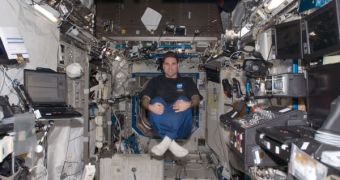Astronauts who spend tours of duty on the International Space Station (ISS) for the average of six months are at a very high risk of losing a high percentage of their bone mass, doctors have recently announced. According to the report, bone loss in those who have stood onboard the ISS can amount to anything between 14 and 30 percent. The latter case puts spacemen and women who return to Earth in the same situation as seniors suffering from osteoporosis, an age-related disease. The new paper shows that the risk of hip fracture is the largest, and also the most dangerous, from a medical point of view.
The researchers have focused their efforts on 13 astronauts that spent the 6 month-long tour on the space station, and have determined that the minimum amount of bone loss has been of 14 percent. This is a very large figure by all accounts, and makes people coming back from orbit suffer the effects of old age decades ahead of their times.
"If preventive measures are not taken, some of our astronauts may be at increased risk for age-related fractures decades after their missions," orthopedic surgery and biomedical engineering professor Joyce Keyak from the University of California, Irvine, who is also the leader of the new paper, says.
Working together with colleagues from the UC San Francisco and the Universities of Space Research Assn, Keyak has analyzed the astronauts' bone mineral density, which was known to decrease at a rate between 0.4 percent and 1.8 percent each month. Following their study of 12 male and 1 female astronaut, the team has decided that the actual drop rate is between 0.6 percent and 5 percent each month.
The main culprit for the loss in minerals and muscle strength while in orbit is microgravity, which, as opposed to gravity, doesn't force the body to produce the minerals in order for it to stand up straight. Due to the fact that we have adapted to our planet in order to survive, our bodies are only constructed to function properly here.

 14 DAY TRIAL //
14 DAY TRIAL //